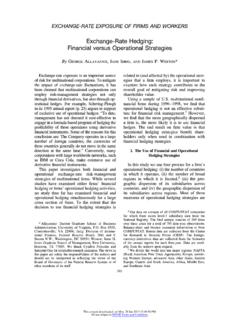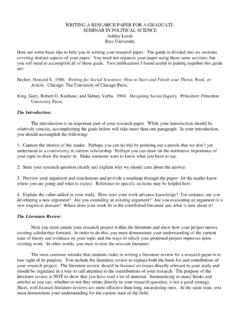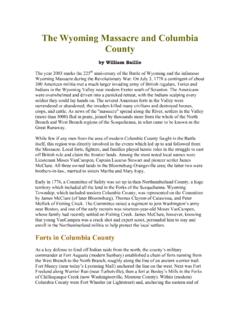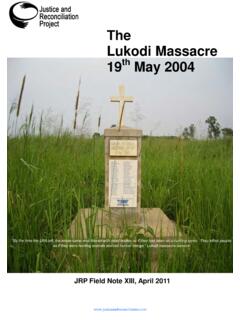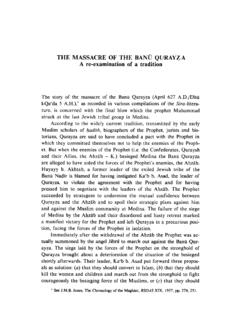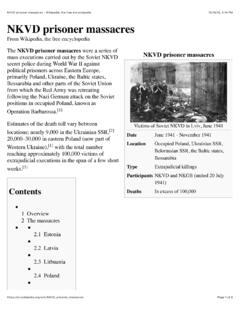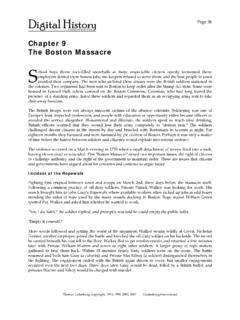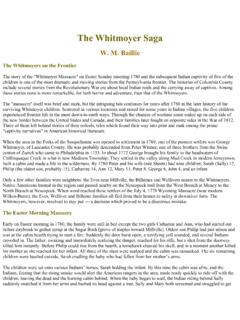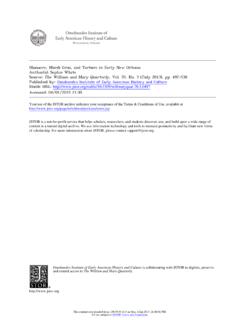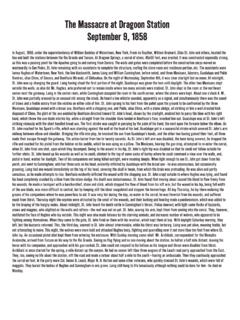Transcription of A Courtroom Massacre: Politics and Public Sentiment in ...
1 A Courtroom massacre : Politics and Public Sentiment in Progressive-Era Virginia By Randal L. Hall JKeminiscing, Floyd Allen's attorney recounted his client's actions in the Courtroom in Carroll County, Virginia, on March 14, 1912: "[Floyd] hesitated a moment, and then he arose .. He looked to me like a man who was about to say something, and had hardly made up his mind what he was going to say, but as he got straight, he moved off to my left, I would say five or six feet, and he seemed to gain his speech, and he said something like this, T just tell you, I ain't a going.'"1 Floyd Allen (1856-1913), a prominent county merchant, farmer, and sometimes Public official, faced a guilty verdict that morn ing for interfering with deputies performing their duties. Upon receiv ing a sentence of one year in prison, Allen announced his refusal to go with the sheriff when the officer moved to place him into custody. As Allen unbuttoned his sweater and fumbled beneath it, gunfire erupted.
2 Floyd, his son Claude (1889-1913), his brother Sidna (1866-1941), and his nephews Friel Allen, Wesley Edwards, and perhaps Sidna Edwards pulled concealed pistols and exchanged fire with Courtroom 1 Testimony of Judge David W. Bolen, transcript of Floyd Allen's first trial, p. 6. (The trial testimony began on May 2 and ended on May 11, 1912.) Copies are available in the Wythe County Circuit Court, Wytheville, Virginia; and as Wythe County Circuit Court, Commonwealth of Virginia v. Floyd Allen, April-May 1912, Ace. no. 28311, Local Government Records Collection (Library of Virginia, Richmond, Va.); hereinafter cited as Allen trial transcript. The pagination of the transcript is somewhat inconsistent in places, but I have included the page numbers nonetheless. I would like to thank Ken Badgett, Walter Beeker, Carlos K. Blanton, Mich?le Gillespie, Ron Hall, Ron Leonard, William A. Link, Bill Lord, the five anonymous referees for the Journal of Southern History, and all participants in the SHOP talk seminar held at the University of North Carolina at Greensboro.
3 Mr. Hall is associate editor of the Journal of Southern History. Managing Editor's note: This manuscript was submitted, refereed, and ac cepted before Mr. Hall was appointed to his present position, and it was copyedited by the former associate editor, Bethany L. Johnson. The Journal of Southern History Volume LXX, No. 2, May 2004 250 THE JOURNAL OF SOUTHERN HISTORY officials, some of whom?such as the court clerk Dexter Goad?had their own illicitly concealed weapons. The battle spilled out of the courthouse, with the building's columns and a Confederate monument in the center of the street providing cover. When the shooting ended, the judge Thornton L. Massie, the sheriff Lewis F. Webb, the com monwealth's attorney William M. Foster, a juror, and a witness in the case lay dead or dying. Floyd and Sidna Allen and Dexter Goad suf fered gunshot wounds, as did several others. The bulk of Carroll County lies on the crest of the Blue Ridge Mountains, though the southern portion includes the precipitous slope of the Blue Ridge chain as it blends into foothills and the bordering Piedmont region of North Carolina.
4 Writers and observers around America automatically applied the worst of Appalachian stereotypes when national headlines blared the news of violence in the county courthouse on that chilly March day. Both the newspaper reports and a flurry of rapidly prepared books by journalists and other outsiders brought the incident to national attention and explained the affair as the work of lawless, bloodthirsty Most subsequent writing 2 Deeply stereotypical books produced quickly include Edgar James, The Allen Outlaws: A Complete History of Their Lives and Exploits Concluding with the Hillsville Courthouse Tragedy (Baltimore, 1912); J. J. Reynolds, The Allen Gang: Outlaws of the Blue Ridge Mountains (Baltimore, 1912); and Edwin Chancellor Payne, The Hillsville Tragedy: Complete Story of the Allen Clan, edited by E. B. Jacobs (rev. ed.; Chicago, 1913), an account by a detective who helped capture the fugitive Aliens. Edgar James notes, "The enterprise of the publishers of this book is shown by the fact that the news of the outrageous riot had scarcely reached the outside world before they had the writer on his way to the scene of the crime.
5 " James, Allen Outlaws, 133. A jailer in Wytheville who guarded the Courtroom (and thus heard the evidence) during all seven trials of the Aliens encapsulated his understanding of the incident in a book-length poem. Samuel S. Hurt, "Gentlemen I Aint A-Goiri" (Wytheville, Va., 1913). Historians studying the southern Appalachian mountains have created two particularly fruitful lines of analysis in recent years, and both approaches must be taken to understand the events in Carroll County in 1912. First, scholars have disproved the many stereotypes of the region that developed throughout the nation in the late nineteenth and early twentieth centuries. The area was not filled with so-called contemporary ancestors, a homogeneously white, impoverished, rural people generations behind the rest of the country, nor were the area's residents the product of a Celtic background that left them uniquely prone to violence and barbaric feuds. Instead, writers and media figures created such stereotypes as part of their own ideological attempts to deal with the industrialization, urbanization, and rapid change occurring in the United States.
6 A second, related line of thought has challenged the argument for Appalachian exceptionalism. The mountain areas, differing greatly even within the highlands, exhibited many of the same historical struggles and developments shared by other regions in the South, though with examples of uniqueness and variation that one would find by looking at any other of the many geographical subregions in the southern states. The feuding and violence in the mountains grew out of the same sources as in the rest of the South?not from unique depravity but from demographic and economic change combined with political compe tition. See John C Inscoe, "The Discovery of Appalachia: Regional Revisionism as Scholarly Renaissance," in John B. Boles, ed., A Companion to the American South (Maiden, Mass., and Oxford, 2002), 369-86; Dwight B. Billings, Mary Beth Pudup, and Altina L. Waller, "Taking Exception with Exceptionalism: The Emergence and Transformation of Historical Studies of Appalachia," in Pudup, Billings, and Waller, eds.
7 , Appalachia in the Making: The Mountain A Courtroom massacre IN VIRGINIA 251 about the killings has been prepared for the purpose of entertainment or by partisan locals debating who deserved blame for starting the shooting. The authors of various songs and books have battled to establish control of the historical memory of the massacre , a rhetorical struggle that has reflected changing local and regional mores. Only recently have writers attempted systematically to analyze the courthouse shooting using documentary sources, and they have shown that the existence of an active two-party political system in the moun tains of southwestern Virginia was a prerequisite for the incident. One master's thesis and two detailed chronicles by amateur historians situ ate the immediate origins of the violence in the context of political opposition and personal animosity between the Aliens?violent but well-to-do leaders in the county's Democratic Party?
8 And Goad, Foster, Webb, and other prominent local Republicans who in the pre ceding few elections had displaced the dominance of the Democrats. With much zeal, Foster won several indictments after a relatively mi nor scuffle involving Wesley and Sidna Edwards disrupted a Primitive Baptist church service held in a schoolhouse in December 1910 by their uncle Garland Allen. In arresting the young men and bringing them back to Hillsville, the centrally located county seat, two deputies, Pink Samuels and Peter Easter, had one brother tied and the other handcuffed as their buggies passed in front of Sidna Allen's store in April 1911. An angry Floyd deemed this to be excessively humiliating, and he forcibly released them from their bonds. The officers alleged that Sidna Allen and Sidna and Floyd's nephew Barnett aided in the release, but trials on those charges had not been held when Floyd's refusal to accompany the sheriff from court triggered the Courtroom bloodshed.
9 At the time of Floyd's trial in 1912, his family's reputation for violence had court officials (and many others in the community) South in the Nineteenth Century (Chapel Hill, 1995); and Inscoe, ed., Appalachians and Race: The Mountain South from Slavery to Segregation (Lexington, Ky., 2001). See also Kenneth W. Noe, "Appalachia Before Mr. Peabody: Some Recent Literature on the Southern Mountain Region," Virginia Magazine of History and Biography, 110 (No. 1, 2002), 5-34. Van Beck Hall, in "The Politics of Appalachian Virginia, 1790-1830," in Robert D. Mitchell, ed., Appalachian Frontiers: Settlement, Society, and Development in the Preindustrial Era (Lexington, Ky., 1991), 166-86, points out that even in the early republic the mountain areas of Virginia did not fit later stereotypes. The political representatives of this diverse and developing area "voted for programs that many historians have associated with progress and modernization" (p.)
10 186). In thinking about mountaineer stereotypes, one must keep in mind that mountain residents were only one of many groups viewed through the lens of cultural chauvinism in the midst of Progressive-era efforts to "Americanize" immigrants and others such as Indians and blacks. For example, see Emory S. Bogardus, Essentials of Americanization (3rd rev. ed.; Los Angeles, 1923), particularly chap. 10, "The American Mountaineer." 252 THE JOURNAL OF SOUTHERN HISTORY nervously anticipating trouble, and at the officials' moment of apparent triumph, they came under Historians have not studied sufficiently the long-term origins of the shootings, nor have they examined in full detail the statewide struggle to define the significance of the violence during the year following the killings?a vivid debate about the cause of the incident and the proper punishment for the Aliens, particularly Floyd and his son Claude. After a manhunt that brought national prominence to the tiny town, several of the Aliens and their relatives endured trials and convictions for murder.


